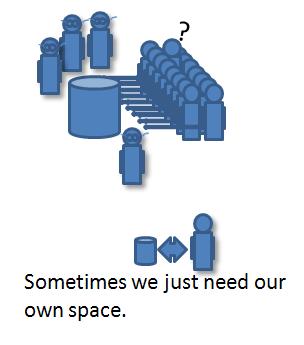« Data mart Data Modelling 101 | Duplicate Data and removing duplicate records »
Business Intelligence Workspaces and in memory self serve analysis
In the classical Business Intelligence architecture, users sit at their computers, requesting reports and analysis, and huge central servers churn through the numbers. The dual-core machine on the desk with 2Gb of RAM is asked to do almost nothing.
As machines get faster and faster, new tools that use memory are going to create functionality and speed that just hasn’t been possible before- and we will have to shift our concepts of what gets done where in the architecture. The desktop is far from dead.

The Advantages of a Business Intelligence Workspace
Forrester Research calls these new tools business intelligence workspaces.
The Datamartist tool that I am creating is an example of a powerful new BI Workspace. It runs on your desktop, takes full advantage of the dedicated hardware, and uses the lightning fast speed of RAM memory to provide performance that server based systems are hard pressed to touch when there are hundreds or thousands of users hitting them with demands.
On top of the speed advantages, a business intelligence workspace provides a level of control and flexibility that is impossible with large, multi user, production systems.
Borris Evelson of Forrester describes a business intelligence workspace as:
“a data exploration environment where a power user can analyze production, clean data with near complete freedom to modify data models, enrich data sets, and run the analysis whenever necessary, without much dependency on IT and production environment restrictions.”
There has been a lot of discussion about memory resident data analysis tools. Analysts get excited and focus on what the tools allow them to do- while IT and management often focus on the relationship between end users and the IT department, with concerns about the new power in analysts hands.
As Mr. Evelson points out in the above quote, with a powerful tool on your desktop that lets you analyse millions of rows, make your own decisions regarding data model and content all in an environment without risk of impacting other users or the production systems, the role of IT might be diminished. I look at these tools as a business intelligence sandbox- the question arises “is this just another way to create more spreadsheet chaos?”
In my opinion, the question to ask is- if we do not provide such powerful tools to analysts what is the alternative- the alternative is where we are heading today- spreadsheet “He” double hockey sticks (to use a Canadian expression), with escalating BI budgets not delivering sufficient value.
Memory based analytics are not going to replace all the tools that came before, nor are they going to make the IT department a fifth wheel. There is no magic fix. But they will provide powerful capability right where it is needed most, and I believe will actually REDUCE the amount of data transformation being done in spreadsheets where it is truly hidden.
I think that handled correctly, they can be an opportunity to bring Analysts and Technical folks together, not split them apart.
Reduce Business Intelligence Cost
-Business Intelligence workspaces satisfy needs that would otherwise have to be addressed by pricey custom developments that are used once and discarded
-They help avoid heavy investments in new hardware/BI appliances that try to deal with performance issues that plague centralised systems
-They offer the possibility of real business value, because by lowering the cost of analysis both in terms of dollars and effort, they allow analysts to try more “what if” scenarios, more quickly
-If the analysts are dialed into the business, that means more insight, more actionable information- and more profits.
I don’t think anyone realisticly thinks that excel is going away anytime soon- it will continue to be used for analysis, graphing and reporting. But I think more and more data sets will be imported into excel after being created in a memory resident BI workspace that allows power users to REALLY get at their data, and do it in a way that is scalable, flexible, and robust.
And being from the IT department in my former life- I think that Business Intelligence workspaces with flexible and well thought out audit and collaboration features will one day bring much more order and value to the business intelligence world than the current tangle of spreadsheets can ever promise.
With the right mix of tools, we can do all this without having to slow down the people who know the data, know what they need, and understand the business value of getting numbers NOW, to make decisions that matter.
« Data mart Data Modelling 101 | Duplicate Data and removing duplicate records »



